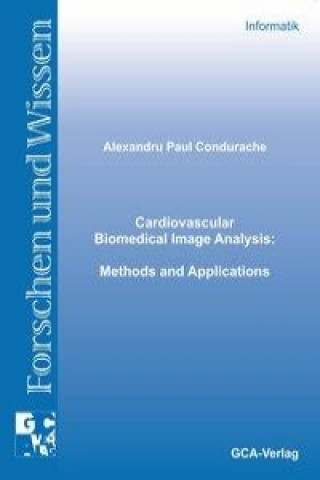
Kód: 12770187
Cardiovascular Biomedical Image Analysis
Autor Alexandru P Condurache
The information technology has already found its way into the hospital where it offers com- plete solutions for the storage, retrieval and transmission of data. For example, electronic patient-files are instantly available on the ... celý popis
- Jazyk:
 Angličtina
Angličtina - Vazba: Brožovaná
- Počet stran: 256
Nakladatelství: Gca Ges.F.Computeranw., 2008
- Více informací o knize

Mohlo by se vám také líbit
-

Dune
216 Kč -

Haunting Adeline
621 Kč -

Berserk Deluxe Volume 2
1092 Kč -

White Nights
89 Kč -

Powerless
267 Kč -

Atomic Habits
330 Kč -

Dune Messiah
228 Kč -

Berserk Deluxe Volume 3
1142 Kč -

One Day
221 Kč -

Berserk Deluxe Volume 1
1115 Kč -

Iron Flame
368 Kč -

Surrounded by Idiots
213 Kč -

Harry Potter and the Prisoner of Azkaban (Minalima Edition)
993 Kč -

Gravity Falls Journal 3
443 Kč -

Heaven Official's Blessing: Tian Guan Ci Fu (Novel) Vol. 1
372 Kč -

The Creative Act
568 Kč -

Dune
276 Kč -

Hunting Adeline
624 Kč -

A Little Life
290 Kč -

Children of Dune
230 Kč -

Heaven Official's Blessing: Tian Guan Ci Fu (Novel) Vol. 2
427 Kč
Informovat o naskladnění knihy
Zadejte do formuláře e-mailovou adresu a jakmile knihu naskladníme, zašleme vám o tom zprávu. Pohlídáme vše za vás.
Více informací o knize Cardiovascular Biomedical Image Analysis
 Anotace knihy
Anotace knihy
The information technology has already found its way into the hospital where it offers com- plete solutions for the storage, retrieval and transmission of data. For example, electronic patient-files are instantly available on the laptops of physicians in a hospital and he can then confer over an transmission channel with a colleague on the other side of the Atlantic about the best treatment. However, the major breakthrough takes place currently in the field of pro- cessing the information, i.e., the introduction of tools to help analyze data and enhance the decision-taking process. The field of imaging and machine-vision support has a large contribution to this break- through as in many diagnostic procedures and indeed all interventions the physician has to visually-observe the ill tissue, analyze the data and take a decision. This dynamic is reflected also in the continuous growth that the branch of medical image technology enjoyed in the last years. This growth is directly related to an enlarging market reflecting in turn the increased in- terest of the society as a whole in improved healthcare and its confidence that such technology is the right answer in this case. Mainstream machine vision has arguably as purpose automatization, i.e., the replacement of humans by machines, like e.g., for quality inspection or for controlling a robotic arm which is supposed to solder a circuit board in the place of a human. Medical machine vision however follows a more synergetic way as it supports the medical staff such as to increase their efficiency and accuracy and it does not aim at replacing them. Such supportive technologies are possible only if a bridge is build between the medical and the computer vision world. We consider this contribution to be a part of this bridge and at the same time a plea for a senseful division of work between machines and humans such that both do what they can best do: the former should be used at painstaking repetitive and analytical work and the latter for creative and decisional work. This collaboration requires from the part of the computer vision specialist an engineering approach to solve the practical problems presented by his medical counterpart. From our cur- rent experience, an optimal solution can be achieved only with the consideration of all prior information available, which implies again a close collaboration. The accent lies in this case on the solution of the problem - and each particular problem has its own particular solution - this Figure 6.1: Dynamic-roadmap flow-chart. CS stands for complete state. represents the novelty element, if the solution includes novel approaches or a combination of old approaches specifically adapted is of secondary importance - although a novel well justified approach clearly increases the value of the solution. This contribution is related to cardiovascular medicine and to imaging techniques which return 2D-projection images. We have described here machine vision methods to enhance the catheter intervention (Section 6.1), for vessel segmentation (Section 6.2) and for the quality control of xenograft heart-valve implants (Section 6.3). Although, in some sense the method- ology used in each case exhibits commonalities given mainly by the imaging and physiological background, we believe this work to be another proof of the principle that particular problems need particular solutions. Such particular solutions can be achieved both by new algorithms and by new parametrizations and/or developments of dedicated algorithms.
 Parametry knihy
Parametry knihy
- Plný název: Cardiovascular Biomedical Image Analysis
- Podnázev: Methods and Applications
- Autor: Alexandru P Condurache
- Jazyk:
 Angličtina
Angličtina - Vazba: Brožovaná
- Počet stran: 256
- EAN: 9783898632362
- ISBN: 3898632369
- ID: 12770187
- Nakladatelství: Gca Ges.F.Computeranw.
- Hmotnost: 374 g
- Rozměry: 205 × 146 × 20 mm
- Datum vydání: August 2008
Osobní odběr Praha, Brno a 12903 dalších
Copyright ©2008-24 nejlevnejsi-knihy.cz Všechna práva vyhrazenaSoukromíCookies



 Vrácení do měsíce
Vrácení do měsíce 571 999 099 (8-15.30h)
571 999 099 (8-15.30h)